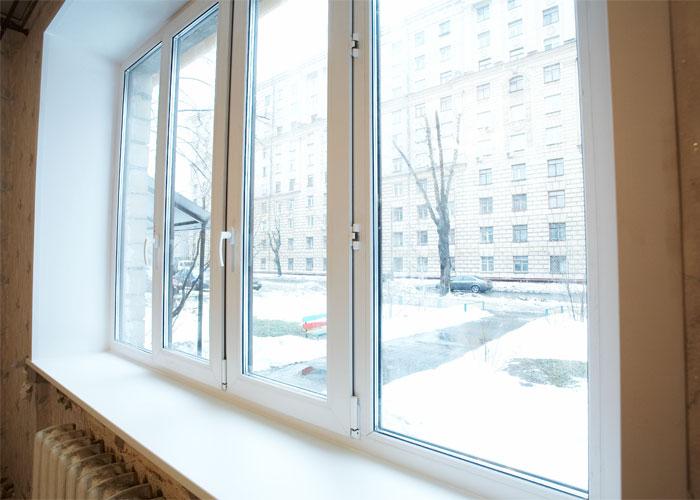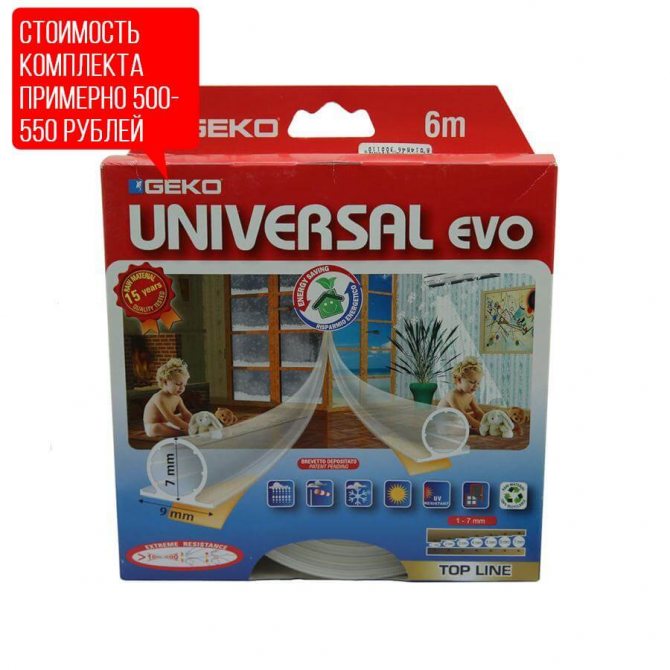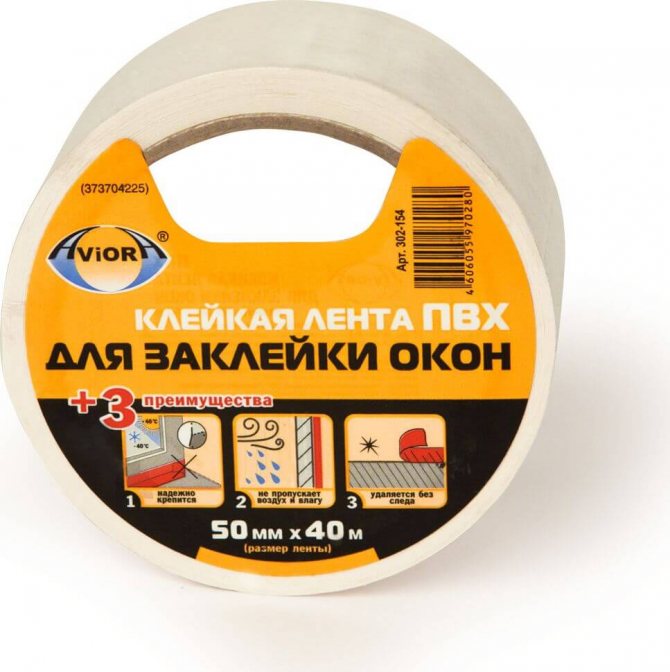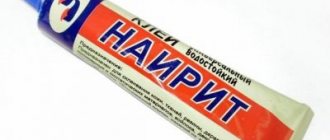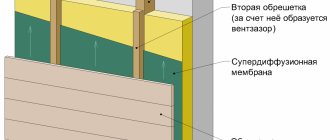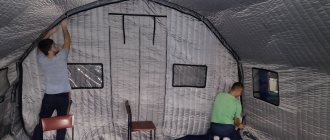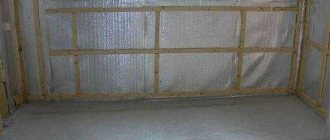With the onset of cold weather, the question arises about the insulation of your home. It is the insulation that makes it possible to save heat and save on heating. First of all, the question of window insulation arises, since large heat losses occur through them.
The best way to insulate is, of course, the installation of new plastic windows equipped with double-glazed windows. But this is an expensive option and not everyone can afford it. There remains the option of insulating old wooden frames.
Everyone knows that over time, wood, under the influence of moisture and temperature changes, warps and crumbles, which entails the formation of cracks and gaps, through which heat is emitted in the future. Glasses move together with the frame, which also contributes to the depressurization of the room.
To make the house comfortable and cozy in winter, it is necessary to inspect the slopes and windows in general annually. Naturally, this must be done before the onset of winter, before the heating season.
Before you start to insulate the windows, you should bring them to their proper form. The service life of window frames is 10 years, but usually the frames are used as much as the whole house, and this is sometimes more than a dozen years.
Therefore, before insulation, it is necessary to carry out a small repair of the frames themselves. To do this, inspect the frames and glass attachment points. If cracks or glass are found that do not fit tightly to the frame, these places should be smeared with a special putty. Excess putty is removed with a dry cloth.
To keep the glasses stronger in the frames, you can hit the nails that hold the glazing beads with a hammer, if necessary, you can add more nails.
If there is a desire to overhaul the frames, then it is better to remove the glass, coat all joints with putty and insert the glass back.
If no putty is available, you can use oil paint. The whole process of repairing a frame using paint as a putty consists of the following steps:
- the glazing bead is carefully removed;
- the glasses are taken out;
- the folds are cleaned of old putty;
- a layer of paint is evenly applied to the folds;
- without waiting for the paint to dry, glass is inserted and a glazing bead is nailed;
- glazing beads are tinted.
You can use the old glazing bead for fixing the glass, but it is better to replace it with a new one. If there is no paint or putty, you can use plasticine, but it is not resistant to high temperatures and at temperatures above 25 degrees can leak and stain the glass.
After the frames have been repaired, you can start to insulate them. Now the question arises: how to glue the windows over the winter?
Before gluing the windows, the surface of the frames should be degreased, this will increase the adhesive properties of the adhesive tape.
To do this, you can use a special liquid for degreasing surfaces, or you can take any alcohol-containing liquid, for example, vodka.
About half a glass of vodka will go to one window. Then the cracks must be filled with insulation.
We use tubular profiles for insulation
There is a very wide variety of insulation materials. More modern are special tubular profiles, often called gaskets. They come in a variety of sizes and shapes.
P, D gaskets are for large gaps, and E gaskets are for small gaps. Tubular profiles have the following advantages:
- invisible;
- firmly attached to one side of the frame: the window can be freely opened and closed, while the tightness is not disturbed;
- service life is about 5 years.
When working with heaters, do not tighten it, since some of them must be glued at a temperature of at least +10. The gluing procedure requires accuracy and patience, so it takes a lot of time.

You can glue the windows with various materials for gaskets: rubber, foam rubber, polyethylene foam, polyurethane, polyvinyl chloride (PVC). In addition, heaters are divided into two types: self-adhesive and those that must be glued with glue. Self-adhesive is more convenient to glue: the protective film is removed and the insulation can be glued.
When buying a self-adhesive insulation, you should pay attention to the expiration date of the glue, which is indicated on the package. If it has expired, then the gasket may either not stick, or quickly fall off after gluing. It is safer to glue the insulation with your own hands. All you have to do is choose the right glue.
The most suitable glue is silicone sealant: it is not afraid of moisture, it stretches and shrinks well in any state. Therefore, it will hold the gasket with repeated slamming.
Silicone sealant can be used as insulation by filling the gaps evenly with a pistol.
After the silicone has hardened, the excess is cut off with a sharp knife. This work must be done carefully so as not to damage the paint on the window. Similarly, you can use polyurethane foam. However, when using it, you need some experience, since it forms a layer that is too thick, which is not suitable for narrow window gaps.
Some qualities of PVC insulation are better than rubber ones: they are frost-resistant, less brittle, do not deform and do not crumble. But rubber wears out less. When choosing rubber heaters, you should choose softer types, since they can withstand deformation a large number of times.
The material of the seal must be indicated on the packaging. All these heaters can be purchased at the construction market or in a hardware store.
Varieties of insulation tapes and tape
Insulation sheets, scotch tape have a number of advantages over other methods of pasting windows:
- The base will hold out without replacement for several years.
- Pasting is carried out independently, quickly.
- No additional materials are required.
- The adhesive base does not leave marks when peeled off, does not interact with the material to which it is glued.
But it is worth considering the disadvantages of this method:
- Papered openings cannot be opened.
- If the strip is poorly glued or of poor quality, it will be difficult to remove, there will be breaks.
Two types of insulation are sold in shops and markets:
- Pasting. This type with a lot of grip. For its production, polyvinyl chloride, rubber raw materials, and foam rubber are used. Has good flexibility, just shrinks to the required size. There are black, white, brown stripes on sale. On the packaging it is written on what size of the gap the canvas fits.

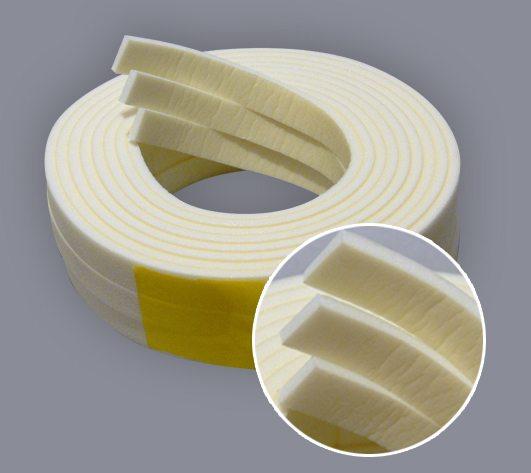
- Sealing. This type is characterized by a void inside the tube, which helps to retain heat. One side is equipped with an adhesive layer. The 7 mm slit is tightly blocked, while withstanding all temperature changes. The color of the strip is selected to match the color of the glass unit.
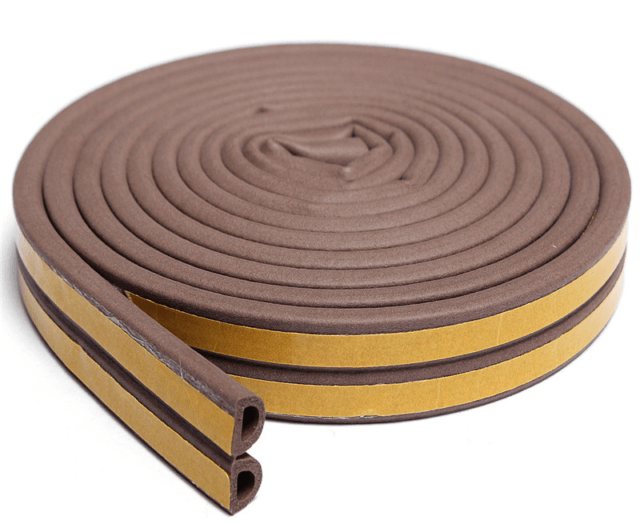

The durability of the glued tape should be checked annually. If replacement is required, then do it for the entire strip or a separate fragment.
Elimination of drafts
Drafts are one of the enemies of heat. Therefore, when insulating windows, you should also take care of the elimination of drafts. To do this, not only the windows should be insulated, but the balcony and entrance doors should be insulated.
The front door can be insulated with felt by nailing it along the contour with nails or glued along the contour with self-adhesive felt, which can be purchased at the store. In addition, in panel houses, you should pay attention to cracks and open joints, which must also be thermally insulated.
From all of the above, it follows that there are many ways to insulate windows and keep warm in the house. Further actions depend on the financial capabilities and personal needs of the owners.
The best, but also the most expensive, way is to install plastic systems. But it is quite possible to use old-fashioned methods to preserve heat in the house, while economically gaining significant benefits.
Watch the video selection
When frost approaches, you don't have to think for a long time. You never know what winter will be like, so it's best to prepare in advance. With the onset of the first cold weather, everyone is looking for ways to insulate their homes, while reducing energy costs.
First of all, you should take care of the windows. It is no secret that poorly insulated windows can become a source of heat loss by almost half. If you are interested in how to glue plastic windows, then this article is for you.
Self-adhesive sealant for plastic windows. Varieties of seals for plastic windows
Plastic windows are reliable and modern designs. But even such attractive products need support and protection of the joints. There is a special seal for this.
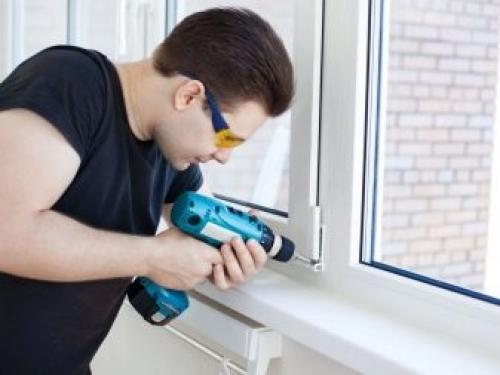

Features of the
It is completely unprofitable to install a new window every time the PVC window seal installed by the installers wears out. The solution is to replace the sealing product with its counterpart. Of course, it should be chosen as carefully as possible. Ideally, you should replace the old sealing layer with exactly the same one, only acquired again. In terms of strength, the seal should be the same as rubber, resistance to temperature effects and resistance to water is equally important; modern products prove to be stable even in winds up to 100 km / h.
Reasons for replacement
There are a number of points indicating that the time has come to replace the branded insert:
- blowing from the window;
- it freezes and becomes covered with ice from the inside;
- condensation is detected;
- drafts have become too frequent;
- torn and cut places, cracks are seen;
- the seal has partially fallen out or gone beyond the grooves;
- in winter it suddenly became noticeably colder than in previous years, although the heating is working normally, the house is insulated and the weather is no worse;
- in the summer months, dust constantly settles on the windowsill, even if the window is locked;
- the window is at least slightly covered with mold or other fungus.
But since the matter is quite serious, it is worth checking in advance whether the insertions are really "to blame".
In the absence of obvious deformations and external integrity, it is better to adjust the plastic window. Repeatedly, employees of repair organizations have encountered just such a situation when violations of the setting worsened the sealing. In such a case, of course, attaching a new seal will only bring additional costs. The problem will not be solved.
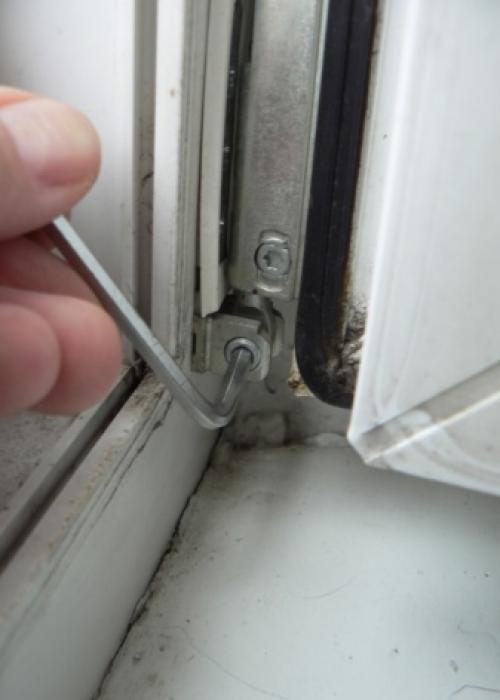

Views
Among the types of window seal for PVC, a prominent place belongs to rubber structures. The role of the seal is to close the outer and inner contours to be protected. With the help of this material, the room is isolated from dust and dirt particles, from the penetration of the ubiquitous noise. Therefore, it becomes more comfortable to operate sealed double-glazed windows. The use of a rubber band, which is made on the basis of vulcanized rubber, helps to increase the tightness of the window and, in addition, reduces consumer costs.
With sharp jerks of temperature (severe frost or heat), rubber behaves badly. It sometimes shrinks and becomes covered with cracks, can be damaged by mechanical stress, which is usually not noticed. Moreover, deformations accumulate gradually, and the impact of negative factors, if not immediately manifested, will in any case reduce the product life.If we focus on cost, it is useful to pay attention to EPDM rubber sealing structures. This material is favorably distinguished by its softness and plasticity, it has no particular drawbacks.
Paper tape
- If you don't want to bother too much, you can tape the window over. In this case, do not hesitate, because masking tape (the most popular in this business) begins to appear on store shelves quite early - in the first months of autumn. If you have not had time to stock up on the necessary equipment, do not worry.
- Alternatively, use regular tape (wide, of course). You will also need a hairdryer to melt ice on the windows and non-sterile cotton wool, which is easy to find at your nearest pharmacy. You need to make bundles of cotton wool, and then place them in the slots.
- Before you start insulating, first dry the windows with a hair dryer - this way the adhesive tape will hold better. The last stage involves sealing with tape. This method will allow you to quickly insulate your house, but it has its drawbacks: such an adhesive material may not adhere well.
Tidying up the window frames
Where to start insulating windows? First you need to take care of the window frames. In general, the average lifespan of a frame is about 10 years. There are few of us who have taken care of them at least once a decade - our frames cost much longer, so before we start to insulate the windows, we will carry out small repair and restoration work.
To begin with, you should carefully study the sash and inspect the glass. If you see any cracks or the glass just doesn't fit tightly, you should coat the voids with a special putty. If there are small surpluses, then they should be carefully removed with a dry cloth. To strengthen the glass in the window frame, you can knock again with a hammer the nails hammered into the glazing beads, and, if necessary, add a few more pieces.
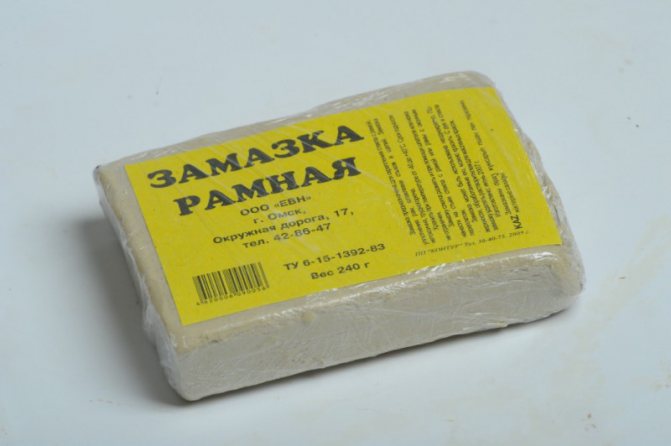

Special window putty
If you are a pedant and are set up for serious work, then, in theory, the glass must be removed from the frame, and after careful lubrication, reinsert them into place. In the event that you do not have putty on hand, you can use oil paint, which also perfectly closes the cracks.
Using paint, the workflow for smearing the gaps will look like this:
- Carefully remove the glazing beads;
- We take out the glass;
- We clean the folds from the old putty;
- Apply a layer of paint evenly to the folds;
- We put the glasses in place and nail down the glazing beads;
- We paint the glazing beads again.


This photo shows how a thorough preparation of the removed frames is carried out.
Attention! Do not wait for the smeared paint to dry. The glass must be inserted immediately after the putty.
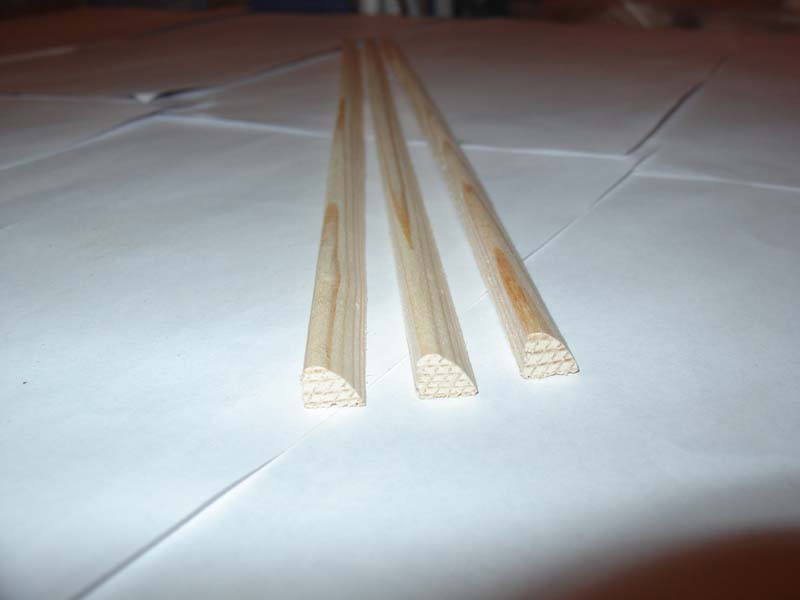

Also, old glazing beads can be replaced with new ones.
As a last resort, if you have neither putty nor oil paint, you can use plasticine. But this option is not very good, since plasticine is still not able to withstand high temperatures - even from heating at + 25 ° C it can leak and stain windows.
Cloth strip
An excellent way to keep your apartment warm in winter is fabric strips. You do not need to specifically buy fabric in the store for this. You just need to take old sheets and make small strips of them. It doesn't take much time and effort.
Next, you need to moisten the strips in water, and then squeeze them out thoroughly, removing the remaining water. The last step: rub the wet cloth with soap and seal the cracks. Soap is a good insulator that doesn't allow air to pass through. The fabric is easy to clean, so when it comes time to open the windows, there will be no problem.
There is also a drawback: due to the temperature difference, there is a possibility that the strips may come off. Then you will have to do the entire warming procedure again.
Attention! It is better to take white fabric so that it is not noticeable on the windows.
.
Selection recommendations
To buy a good tape, you need to orient yourself according to the criteria:
- Material: foam rubber, PVC, rubber, PPE. Foam tape is very affordable, flexible, capable of sealing gaps of various sizes, but the pore structure quickly absorbs moisture, which leads to subsequent deterioration of the raw material. PVC is stronger, resists moisture, stretches. The rubber base can be self-adhesive, sealing tape. It contains rubber, which gives plasticity and temperature stability. PPE is made of foamed polyethylene. Very high flexibility makes it possible to apply for small window imperfections. Use at very high temperatures is inadmissible, as a toxic compound will be released.
- Manufacturers. A lot of them. There are tapes from domestic representatives, there are from foreign ones. The most popular are: Profitrast, KIMTEC, Sanok. Domestic brands are not inferior in quality to foreign ones, as they are made according to European standards and technologies.
- Price. The tape can be purchased by the meter or by the bay. Domestic materials are more accessible than foreign ones. So the tape of domestic production costs about 15 rubles per meter, and quality from Germany - 50 rubles.
Cotton wool or foam rubber
To improve your winter comfort, use cotton wool or foam rubber. These materials are suitable for sealing large gaps such as between window sashes, between sash and window sill. For this method, you will need duct tape over the foam / cotton wool.
It will keep you warm better. It will be necessary to insulate windows in this way every year, since the material absorbs moisture and lags behind over time. Advice! On top of cotton wool or foam rubber, you can also glue ordinary white paper, which will stick to the tape.
Replacing the seal on plastic windows. What is a seal
The seal is an elastic, resilient material installed in two contours along the entire perimeter of the glass units and one contour in the frame and sash.
What are we for
The role and value of seals in PVC windows depends on the place of their installation. In insulating glass units, sealing rubber bands:
- fix the glasses in the profile;
- ensure the tightness of the sash.
On the frame and sash, the seal is installed only where the window opens. He:
- prevents cold air from entering the room in winter;
- protects apartment owners from excessive street noise;
- protects the room from street dust, pollen from flowering trees, volatile fats, insects;
- creates comfortable operating conditions for window fittings.
Where are
To carry out repairs, you need to know where the seal is located. It is installed in three places:
- Between the plastic of the sash and the glass unit - protects the sash rebate from moisture and cold penetration from the street. It wears out the least, since it does not have any loads - only the effect of temperature changes. With regular care, it can last up to 25-30 years. The replacement is difficult - it is necessary to remove the glass from the sash. But the work can be done by hand;
- Between the glass unit and the glazing bead - increases the level of sealing of the window glass in the casement. It also has a long service life, while changing the rubber band is much easier: there is no need to dismantle the glass;
- In the vestibule - the place where the window sash joins the plastic frame. Stands on the profile of both elements of the window structure. It is exposed to intense physical stress when opening and closing a window, and therefore wears out over time. In this case, replacing the rubber window seal is simple - no special knowledge and skills are required.
Old wooden windows
- Wooden windows will last you an average of about one dozen years, and then they will begin to crumble, crumble and lose their properties. Before proceeding with the insulation, is it necessary to inspect the window? and repair the frames if necessary.
- If you notice that there are cracks or the glass does not adhere well to the frame, use putty and wipe off the excess with a dry cloth. If you do not know what is the best way to strengthen wooden windows, then you will need a hammer and nails.
To get started, walk with a hammer over the places where the nails hold the glazing beads. Add more nails if the glass does not hold well.
Advice! For best effect, remove the glass and apply putty over all joints.
.
How to insulate windows for the winter
Polyurethane foam
Large gaps between the wall and the window frame, under the window sill are closed with polyurethane foam.
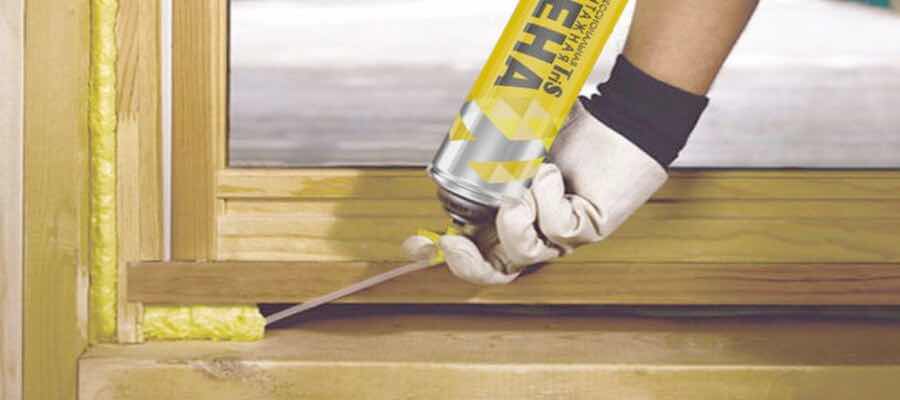

Gloves and glasses should be worn before work.
- Keeping the cylinder in an upright position, remove the cap from the adapter and put on the gun.
- The can is shaken for 30 seconds.
- The seam is moistened with water or an activator.
- The cylinder is turned over to the working position and set to work.
- The seam is filled with zigzag movements. If the seam is vertical, then the movement begins from the bottom up.
- If there is foam in the can and you want to use it, do not remove the gun. Just clean it from the outside.
The release of foam is accompanied by a sharp increase in volume, so it is necessary to put safety struts against window deformation.
To solve the issue with cracks in the frames, you can use old-fashioned methods or buy ready-made heaters in the store.
Sealant and putties
The first step will be cleaning and degreasing the window. Next, remove the glazing beads. The sealant is applied between the frame and the glass, the window sill. You will need a special tool, a construction gun, to ensure even application.
The sealed area must dry completely. At the end of the procedure, insert the glazing beads back. Putty works the same, but it will take more time and your efforts. Buy it at any hardware store.
"Paste"
You will need flour and water to make your own gum. For 1 liter of water, take half a glass of flour, mix and put on fire. After the mixture has cooled, it can be stored for no more than 2 days.
Sun protection
Sunlight can sometimes not only please, but also create discomfort, especially in summer. To make their life easier in the summer, many are in a hurry to seal the windows from the hot sun. You can resort to a procedure such as toning, but there are cheaper ways.
For example, why not cover the windows with foil? Purchase regular food foil. It can be glued both indoors and outdoors. The second option is more effective, since sunlight is reflected, almost without penetrating the apartment.
We insulate plastic windows
With the onset of the cold season, the question of preserving heat in the room, especially if the windows are wooden, arises quite sharply. For additional insulation, methods are used that have been proven for years and decades, effective since the time when plastic windows were not yet invented, how to seal the windows for the winter is decided on the spot. It depends on the material available.
First, the windows themselves need to be prepared. First, you need to peel off all the old paint with a spatula, which peels off and comes off with scales. Seal all holes, cracks and holes in the frames. Lay a synthetic winterizer or cotton wool between the sashes and slopes, you can do this with tow, wet crumpled newspapers are also suitable, which, as they dry, straighten and fill the cavities in the windows. Coat the joints of the frame and glass with putty, plasticine or glue each glass with a narrow transparent tape on both sides. After that, you need to glue everything additionally with strips of cotton fabric or paper.
Paper for pasting windows
More precisely, paper putty. This is the cheapest method, as it only requires a selection of old newspapers and water to seal the windows. To increase the effectiveness of the putty, you can add 2 parts of crushed chalk or 1 part of clay to it.The resulting mass is characterized by high plasticity, which makes it easy to seal even the smallest cracks.
Price: 0 rub.
Pros: Free and easy.
Cons: the need for annual repetition of work, there is no way to open the sealed window, it is not aesthetically pleasing and the presence of additional decor in the form of gluing paper or fabric strips.
The first way
Necessary materials:
- Old sheet;
- soap;
- water.
A cotton or linen sheet must be torn into strips 8-10 cm wide. You need to prepare a lot of such strips, as many as there are cracks in windows and window sills, as many strips are needed. It is better to clean the sill and window and wipe dry. Prepare a basin of water. A strip of fabric is laid out over the entire length of the window sill and coated with a piece of soap dipped in water. Repeat the action two or three times until the fabric is saturated with soapy water. Pick up at one end and glue to the upper edge of the window. Then perform the same operation with all four sides and additionally at the junction of the window frames. Windows are glued tightly for the winter, except for the vents. Thus, the space between the frames and inside the room is better closed.
Why is blowing
The reasons for the depressurization of windows can be different. In plastic, rubber seals dry out, cracks appear in the slopes. In high-rise buildings, corner windows of the upper floors suffer more often - the sashes are warped.


Wooden frames suffer from shrinkage, cracking when the house subsides. Seasonal fluctuations in temperature and humidity are also not good for the tree. Although the shelf life of wood treated with antiseptics is comparable to the life of a person, it also comes to an end sometime.
Problems with window sills and slopes require drastic measures - repair or replacement.
Second way
Materials:
- starch;
- water;
- flour;
- brush;
- the cloth;
- paper stripes.
In the second case, the preliminary preparation is exactly the same, the adhesive is different. For this, a homemade paste, cooked over a fire, is used. For one liter of water, you need to take half a glass of flour or starch. Stir and cook, stirring constantly. Or dilute it in one and a half glasses of cold water and pour it in a thin stream into a saucepan with the remaining boiling water. Cool down. Apply to strips of cloth or paper with a soft paint brush. A regular foam sponge will work as well. Such a paste can be stored for no more than two days. When dry, it leaves a whitish tint on the fabric, so it is better to use a white sheet for gluing.
Sixth way
Prepare:
- sugar;
- water;
- material.
For one glass of sugar, take half a glass of water, stir and put on low heat, stirring all the time. Boil a light syrup. Dip the fabric into it and stick it on the window. And although the result is not worse than in the previous versions, this method is suitable if there is nothing suitable besides sugar. Fabrics that are soaked in a sweet composition can attract ants and other insects into the room. It is better to use one of the previous methods.
In addition to original methods and materials, there are also industrial products designed for insulation:
- transparent tape;
- adhesive plaster;
- foam rubber on a sticky basis;
- assembly tape;
- fabric-based scotch tape;
- foamed polyethylene on an adhesive strip.
The last list is best suited for plastic windows. And although it is generally believed that they are much more effective than wooden ones and protect the room from the cold, sometimes it happens that gaps are formed at the points of attachment of the hinges or between the slopes, which must also be glued to prevent drafts.
The problem with wooden windows is that cracks form in them over time. Over the decades of operation, many ways have been invented to get rid of drafts, but the best of them is to install sealed double-glazed windows.If this is not possible, the most affordable materials will help to glue the windows for the winter.
"Folk" methods of sealing cracks in windows
The newspaper should be cut into strips of equal thickness (4-5 cm is enough), soaped and glued in the right place. You can use wallpaper glue instead of soap. For this method of sealing, preliminary additional insulation of the window with cotton wool is required. This method is good because it is easy to remove the paper in spring by moistening it with water. Instead of a newspaper, you can take any unfinished paper. Window paint will not suffer with such insulation.
You can dampen newsprint and twist it into bundles that fit into the slots between the frames. With the same success use paper towels, rags, cotton wool. From the inside of the frames, you can stick foam rubber strips and close the window tightly. Or seal the cracks with masking tape or regular adhesive tape.
Modern ways of gluing windows for the winter
One of the most effective is considered to be sealing the cracks with a transparent silicone sealant. It is applied evenly with a pistol. After the silicone hardens, its excess is cut off with a sharp knife. In order not to damage the paint on the window, this work must be done as carefully as possible. Instead of a sealant, you can use polyurethane foam, but here you need the skill of working with this material: the foam tends to form a layer that is too thick, unnecessary for small window gaps.
The trade network sells special rubber-based adhesive tapes. One window will require at least 10 meters. The strips are of different widths, which allows them to close even rather large gaps in old wooden frames. The technology of gluing windows for the winter is quite simple and does not require a lot of labor.
Regardless of which method of insulation was chosen, preliminary degreasing of the window will be required in those places that need to be sealed. This can be done using any liquid that contains at least 50% alcohol. If, in the case of tape, the window is not degreased, it will not stick tightly to the frame and will come off after a few days. Sealing of cracks begins only after the alcohol-containing liquid has dried. If old paint comes off and peels off, it is recommended to remove it with a chisel or other suitable tool.
Before the onset of cold weather, everyone thinks about the question: how to make the windows warm. With the constant rise in energy prices, this problem becomes especially acute. After all, it is known that due to poorly insulated windows, up to half of the heat is lost. Modern insulation materials are quite varied and their use leads to significant heat retention. Insulation of windows in the apartment and, accordingly, the rejection of the use of electric heaters will allow you to save electricity per year up to 4000 kW. And this is a significant amount.
You can cut the paper into strips and use soap to attach this design. Some people use silicone sealant or tape for these purposes. You can use glue for. There are a lot of methods. The use of modern insulation materials has greatly simplified this procedure. With strict adherence to the instructions, the indoor temperature can rise by 5-6 degrees.
The oldest insulation method is tape. It is sold in rolls. To stick it, you need to apply some kind of glue base. Sometimes soap is used for such a base, sometimes paste is cooked in flour. Sometimes, following grandmother's recipes, even kefir is used for the adhesive base. However, as a rule, such a design, where the insulation is a tape, does not last long and retains heat poorly.
Insulation with tape for windows
The easiest way is masking tape. But, as a rule, such materials are sorted out already in September-October. And hindsight simply cannot find special tape for pasting windows in the season.In such cases, you can use regular wide tape. For insulation, you will also need a hair dryer and cotton wool. A hairdryer is necessary in case of icing - to dry the ice. If you do not thoroughly dry the sealed areas with tape, it will immediately come off. It is better to buy cotton wool at a pharmacy (you need to take non-sterile). We roll up bundles from it, with which we carefully seal the cracks. If the slots are narrow, then you can do without cotton wool. Glue adhesive tape on top of the dried window. This method of pasting is the most economical and relatively fast. But it has its drawbacks: the scotch tape can fall off and have to be pasted over again.


Insulation of windows with foam rubber
Pasting with foam rubber on an adhesive basis is another economy option. There are a lot of such insulation in stores. It is suitable for both wooden and plastic windows. The adhesive base of the foam rubber will keep the insulation throughout the winter. The only drawback is that the foam rubber absorbs a large amount of moisture. Due to this, the tightness of the foam strips decreases over time.
Sealing with silicone sealant is more suitable for wooden windows. Before you start insulating, you need to remove the glazing beads. The sealant is applied in a thin layer in the grooves between the glass and the frame, in the cracks in the frame, as well as between the frame and the window sill. Before using it, you should thoroughly clean it from dust. A special construction gun is used to apply the sealant. The nozzle on the tube must be cut to the mark. Only then can the sealant be installed in the gun and used. After hardening, the excess silicone can be removed with a knife or spatula. After that, glazing beads are installed on the silicone.
Insulation is possible with window putty. This putty looks like gray plasticine. You need to knead it well and seal up all the cracks. When the putty hardens, it becomes very dense and does not allow air to pass through. You can get rid of this putty in the spring. To do this, simply open the sash and scrape it off with a knife. This putty is sold in hardware stores in a carefully packed state. The putty cannot be stored in the open form, it will quickly deteriorate. One package is usually designed for a whole window. However, it must be borne in mind that work on insulation with putty will require patience and perseverance from you.
The most reliable and durable way is the rubberized seal. The cost of such insulation will be much higher, but it will also be higher in quality. There are three types of rubber seal, which differ in thickness. For plastic windows, a class "E" seal is suitable. Its thickness is 2-3.5 mm. One pack of E sealant (10-12 m) should be enough for 4 windows. The sealant of category "D" (3-8 mm) is intended for wider gaps, and it is better to use it for. The "P" class seal has a width of 3 to 5.5 mm, suitable for plastic and wood. The advantages are obvious: it does not take too long to complete the work, this material is durable and does not absorb moisture. To carry out insulation with a rubberized insulation, the surface should be thoroughly washed and dried. Otherwise, the adhesive base of the seal will slip off, and its adhesion will be unreliable.
Insulation with glue for plastic windows
Insulation can also be done with special glue. This material can be used to seal cracks and joints, as well as perform the function of a sealing seam, as it retains relative elasticity. To use the glue, the window must be well cleaned of dust and moisture. To seal the cracks, the glue is usually not smeared, but a small roller is specially left, which disappears during the drying process. The drying time for some types of such glue is up to 8 weeks. The glue is produced in 310 ml cartridges; work with it is carried out using a construction gun.An important advantage of working with such glue is its white color, which provides complete masking of cracks. Glue for plastic windows can be used to seal seams up to 5 mm.
When working with glue, the following precautions must be observed:
- while working with glue, fresh air is required;
- smoking and the use of open fires are prohibited near the work;
- it is forbidden to pour the remnants of the glue into the sewer;
- do not allow glue to get into eyes.
Thus, there are many ways to insulate windows. But any insulation that you choose should fulfill its function - to keep the warmth of your home.
How to glue the seal on the windows. How to choose how to glue self-adhesive insulation for windows
With the onset of cold weather, the owners of apartments and houses have a problem in the form of window frames that allow heat to pass through strongly. And if 5-10 years ago you had to use old methods - from newspapers, cotton wool to strips of fabric, now you can find simple and effective materials on the market. One of these is self-adhesive window insulation. What it is and how to work with it - you can find out below.
The main materials from which the insulation is made are rubber, PVC, foam rubber and polyethylene foam. On one side of the insulating tape, an adhesive composition is applied, protected with special paper. When the insulation is applied, the paper is removed.
Insulation materials are delivered in the form of cut strips, combined into bobbins, or in the form of formatted rolls.
Rubber
They differ in the lowest price among analogs. They effectively retain heat and are attached with glue or a stapler. Among the disadvantages is poor resistance to moisture: when water gets on the rubber, the material quickly peels off.
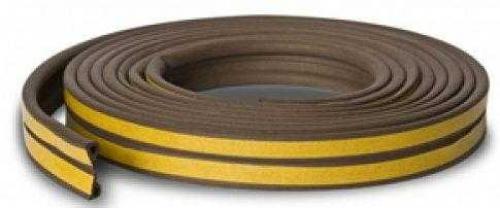

In the photo - rubber self-adhesive insulation for windows
If you buy a rubber insulation, then it is the softest. Rigid models do not adhere well to the window and allow heat to pass through.
PVC
Reliable and environmentally friendly insulation, which is characterized by good frost resistance and resistance to deformation.


On the photo - PVC self-adhesive insulation for windows
When choosing, it is important to pay attention to the rigidity of the product: excessively hard models will not adhere well to the surface. The service life is 2-3 years.
Safe in operation and reliable insulation. In addition to thermal insulation, they provide good protection against extraneous sounds. Foam insulation is supplied in the form of strips. Of the advantages of such seals, one can single out the low cost and the provision of air flow for the room.
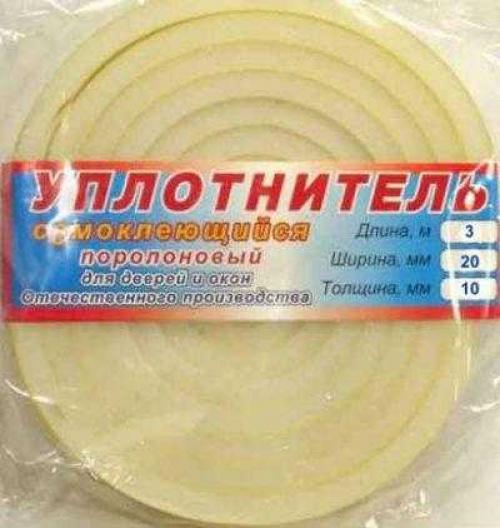

On the photo - self-adhesive foam insulation for windows
However, in terms of thermal insulation, foam rubber is significantly inferior to PVC and polyethylene foam, plus it quickly peels off the surface.
Digit: the shelf life of foam rubber is 1-2 years.
Foam polyethylene
They are bundles made of foamed polyethylene. They perfectly retain heat, provide sound insulation and even protect against moisture release on the balcony. The most expensive heaters among those presented. The service life is 3-5 years.
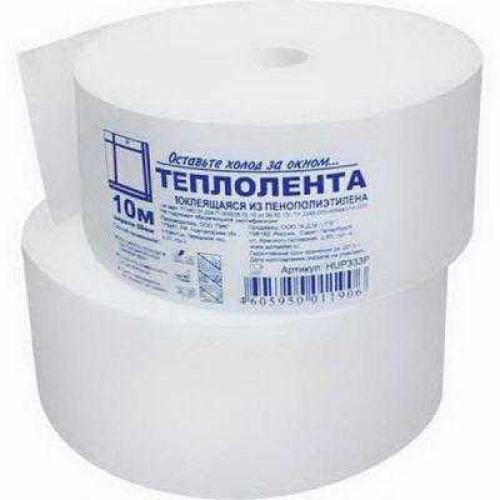

On the photo - polyethylene foam self-adhesive insulation for windows
Benefits and characteristics
Advantages and technical characteristics of self-adhesive insulation include:
- Frost resistance. Depending on the material from which the insulation is made, its thermal conductivity coefficient varies. However, it is at a high level for all: after application, the tape will maximally limit the contact of the room with the environment and prevent drafts and cold bridges.
- Versatility. The insulation is suitable for gaps up to 7 mm wide.
- Reliability. The material is not afraid of temperature extremes, moisture, chemical influences.
- High quality soundproofing. Most of the types of insulation are able not only to protect the room from frost, but also from extraneous sounds.
- Environmental friendliness.The materials do not come into contact with the environment or react with chemicals. Insulation materials are absolutely safe for human health.
- Convenience. After application, the insulation will not interfere with the closing and opening of windows. And the installation process itself does not require the help of specialists: the owner of the house will be able to insulate the window on his own.
- Low cost. In comparison with other methods, self-adhesive insulation has an optimal combination of price and quality.
- Variety of colors. Among them - white, black, dark brown, which allows you to choose the material to match the windows, providing a harmonious appearance of the finished structure.
- Fire safety. The materials from which the heaters are made are classified as low-flammable and hardly flammable.




